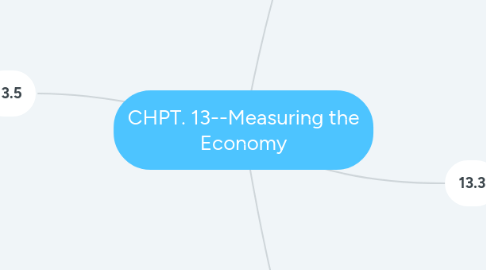
1. 13.2
1.1. 1.GDP and What the Economy Produces-GDP is the main measure of an economy and GDP is the total indicator of all of a countries economic output.
1.1.1. 1.Gross Domestic Product-is the market value of all final goods and services produced within a country during a given period of time.
1.2. 2.How to Calculate GDP-They calculate it by measuring the goods and services produced by the country.
1.3. 3.Inflation and How it Affects GDP-It is used to show how big an economy is and if it is growing or shrinking. GDP can be calculated with and without inflation and how inflation effects the economy.
1.3.1. 2.Nominal GDP-measures the output of an economy valued at today's prices, or in current dollars.
1.3.2. 3.Real GDP-measures the output of an economy not in current dollars, but in constant dollars.
1.4. 4. How the Growth of GDP Can Help People in the Future-As the GDP of a country increase so do other factors such as, literacy and education, health and life expectancy, and standard of living.
2. 13.3
2.1. 1.How the Government Measures Unemployment-Every month the BLS reports how many people are currently unemployed for the previous month.
2.1.1. 4. Unemployment Rate-the percentage of the labor force that is seeking work.
2.2. 2.Full Employment and the Natural Rate of Unemployment-Some people will always be out of work even in an economy with full employment.
2.2.1. 5. Natural Rate of Unemployment-When an economy reaches full employment, jobs exist for everyone who wants to work, even though a certain percentage of those jobs and workers will not yet have been matched together.
2.3. 3.Problems with the Unemployment Rate as an Indicator of Economic Health-The problem is that many people have become discouraged and gave up on finding work. Another problem is that it does not recognize people who work part time.
2.4. 4.The Economic Costs of High Unemployment-You lose potential output from being unemployed. Unemployed people pay a serious economic cost and also bring down society as a whole.
3. 13.4
3.1. 1.Tracking Inflation-They track inflation by gathering information of Americans cost of living.
3.1.1. 6. Inflation Rate- is the percentage increase in the average price level of goods and services from one month or year to the next.
3.2. 2.Adjusting for Inflation-The cost of all goods and services is Nominal Cost of Living. While Real Cost of Living is the same thing but
3.2.1. 7. Cost of Living Index-it serves as the primary measure of inflation in the United States.
3.3. 3.Different types of Inflation-When the inflation is gradually growing it is creeping inflation. When it increases dramatically it's hyperinflation. When is decreases a lot it is known as deflation.
3.3.1. 8. Wage-price spiral-Whether caused by increased demand or rising costs, inflation can set off a kind of “feedback loop”.
3.4. 4.Economic costs of Inflation-You lose some purchasing power, have a increase in interest rates and you lose out on economic efficiency.
4. 13.5
4.1. 1.Phases of the Business Cycle-Expansion, is where it is growing. Peak is when it reaches it's maximum growth point. Contraction is when it is shrinking or decreasing. Trough is when is reaches it's lowest point.
4.1.1. 9.Business Cycle-the recurring periods of growth and decline in economic activity that all economies experience.
4.2. 2.Economic indicators of the Business Cycle-A business cycle goes through 3 indicators. One is that it rises or falls months before an expansion or contraction. One that consistently rises or falls during a expansion or contraction. Finally one that rises or falls months after an expansion or contraction.
4.2.1. 10. Leading Economic Indicators-Measures that consistently rise or fall several months before an expansion or a contraction begins.
